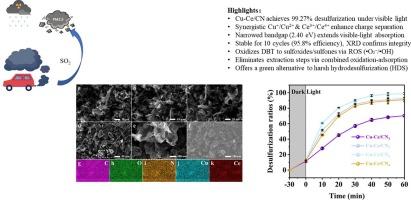可见光下Cu/ ce石墨氮化碳对柴油的超深度脱硫:清洁燃料生产的可持续方法
IF 9
1区 工程技术
Q1 ENGINEERING, CHEMICAL
引用次数: 0
摘要
燃烧含硫柴油会释放硫氧化物和硫酸盐颗粒物质等有害污染物,对环境和健康构成重大风险。传统的脱硫方法往往存在碳和氢的损失,降低了燃油效率。本研究通过水热法开发Cu/Ce共掺杂石墨氮化碳(Cu-Ce/CN)光催化剂,在可见光下进行超深度脱硫,解决了这些挑战。综合表征技术(SEM, XPS, XRD, UV-Vis DRS, BET)证实了Cu和Ce在CN基体上的均匀分散,Cu以Cu+/Cu2+的形式存在,Ce以Ce3+/Ce4+的形式存在,形成了“电子桥”,增强了电荷分离。优化后的Cu-Ce/CN(1:1)具有窄带隙(2.40 eV)、可见光吸收范围扩大、比表面积大等特点,有利于活性氧的高效生成。在最佳条件下,该系统在60 min内实现99.27 %的脱硫率,并通过光催化氧化将难降解的硫化物如二苯并噻吩(DBTs)降解为亚砜/砜。循环试验证明了优异的稳定性(10次 循环后效率为95.8% %),XRD证实了结构的完整性。本文提出了一种可持续、高效的柴油脱硫策略。本文章由计算机程序翻译,如有差异,请以英文原文为准。

Ultra deep desulfurization of diesel over Cu/Ce-graphitic carbon nitride under visible light: a sustainable approach for clean fuel production
The combustion of sulfur-containing diesel fuels releases harmful pollutants such as sulfur oxides and sulfate particulate matter, posing significant environmental and health risks. Traditional desulfurization methods often suffer from carbon and hydrogen loss, reducing fuel efficiency. This study addresses these challenges by developing a Cu/Ce co-doped graphitic carbon nitride (Cu-Ce/CN) photocatalyst via a hydrothermal method for ultra-deep desulfurization under visible light. Comprehensive characterization techniques (SEM, XPS, XRD, UV–Vis DRS, and BET) confirmed the uniform dispersion of Cu and Ce on the CN matrix, with Cu existing as Cu+/Cu2+ and Ce as Ce3+/Ce4+, forming an “electron bridge” to enhance charge separation. The optimized Cu-Ce/CN (1:1 ratio) exhibited a narrowed bandgap (2.40 eV), extended visible-light absorption, and a high surface area, facilitating efficient generation of reactive oxygen species. Under optimal conditions, the system achieved a 99.27 % desulfurization ratio within 60 min, degrading refractory sulfides like dibenzothiophenes (DBTs) into sulfoxides/sulfones via photocatalytic oxidation. Cycling tests demonstrated excellent stability (95.8 % efficiency after 10 cycles), with XRD confirming structural integrity. This work presents a sustainable and efficient strategy for diesel desulfurization.
求助全文
通过发布文献求助,成功后即可免费获取论文全文。
去求助
来源期刊

Separation and Purification Technology
工程技术-工程:化工
CiteScore
14.00
自引率
12.80%
发文量
2347
审稿时长
43 days
期刊介绍:
Separation and Purification Technology is a premier journal committed to sharing innovative methods for separation and purification in chemical and environmental engineering, encompassing both homogeneous solutions and heterogeneous mixtures. Our scope includes the separation and/or purification of liquids, vapors, and gases, as well as carbon capture and separation techniques. However, it's important to note that methods solely intended for analytical purposes are not within the scope of the journal. Additionally, disciplines such as soil science, polymer science, and metallurgy fall outside the purview of Separation and Purification Technology. Join us in advancing the field of separation and purification methods for sustainable solutions in chemical and environmental engineering.
 求助内容:
求助内容: 应助结果提醒方式:
应助结果提醒方式:


